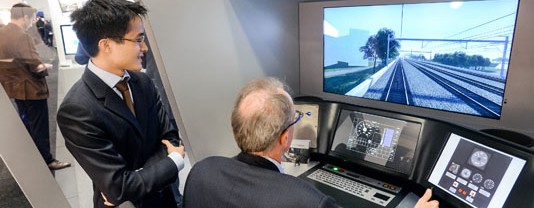Less than two months ago we all met up in Berlin for InnoTrans – the aim was to get an idea as to what the future holds for rail transport and its industrial supply chain. As always InnoTrans (this year at its tenth edition) proved to be an intense occasion, packed with events, the latest developments and discussions. The overall summary which we can make is that the sector is very much alive, full of prospects and that all over the world the railways are increasingly more at the centre of transport policies thanks to their higher level of environmental sustainability and their capacity to untangle the problem of mobility in large urban areas which are becoming more and more densely populated. The rolling stock and infrastructure market, according to analysts, is destined to grow at a rate of 2.7% between 2017 – 2019 with higher percentages of growth in Asia and North America. Technological innovation will have a fundamental role in this growth: the trains and railway lines of today and tomorrow will be very different from those of just 20 years ago.
The Italian rail sector is one of the leading players in this innovation. In fact AnsaldoBreda and Bombardier with Gruppo FSI chose InnoTrans for the unveiling of the very first ETR 1000, built for Trenitalia, which can reach speeds of up to 400 km/h. It should be underlined that the number of Italian companies exhibiting with their own stands at Berlin totalled 180, third in terms of numbers, out of all the countries taking part. In this edition of Railway Engineering, as well as talking about InnoTrans, we could not overlook a very important anniversary: Italferr, the engineering company belonging to Gruppo FSI, was 30 years old on 25 October. An historical achievement because over the last three decades Italferr has become one of the sector’s most important and authoritative companies in the world. We have dedicated two articles to this anniversary: an interview with the company’s CEO, Matteo Triglia and an article which covers the history of the company and looks back at its milestones and successes in Italy and abroad. Today Italferr has extended its activities to sectors which are not strictly “railway orientated” such as the contract they have recently been awarded to manage the works for Milan Expo 2015.
Then we continue our journey among RFI’s Maintenance and Operations Departments, discovering a complex and highly professional structure thanks to which the circulation of thousands of passenger and freight trains is guaranteed every day. This time we are focusing on the Maintenance and Operations Department for Lazio and consequently the huge railway hub in Rome, one of the most complex in the country. A well known saying says “All roads lead to Rome” which is one way of remembering that the heart of the country is its capital where all the most important decisions are made. In much the same way “all railways lead to Rome” because the network’s main hub lies in the capital. Even when it comes to the high-speed network, despite having a fundamental stronghold in Milan, the country’s economic capital, all its major connections converge on Rome. Thanks to an interview with Mr. Massimo Iorani, engineer and manager of the RFI Maintenance and Operations Department for Lazio, we have uncovered the organization of the structure he is responsible for and some interesting development projects.
To complete this edition we have the usual technical articles which are the result of our collaboration with the Italian College of Railway Engineers. We hope you enjoy your read.
Franco Tanel
